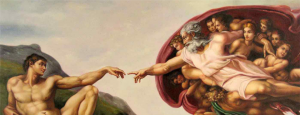Reality begins with consciousness, which may be analogous to a cosmic singularity. Within consciousness there are two perspectives. The first, in order of development, is subjectivity, in which consciousness is spontaneously aware of its singularity.
The second is objectivity, which begins to develop as external objects and events present themselves. The consciousness becomes curious about what might lie outside itself. It seeks to know, and gradually becomes aware of the possibility of The Other.
In pursuit of The Other, the consciousness must address a contradiction: the inspiration for its pursuit is subjective and spontaneous while the execution is objective, deliberate and proactive.
The consciousness contains the contradiction in a synthesis which, like the pursuit itself, is an act of primal creativity (a “big bang”, to labour the cosmic analogy). This creativity leads to the idea of the relationship between Self and Other, which is itself a synthesis of the subjective and the objective.

Suspect ideology. Great pic, though…
But this synthesis comes under pressure as it transpires that the relationship between Self and Other is asymmetrical: there is only one Self, but there are many Others.
The asymmetry can be oppressive and may lead to a breakdown in the relationship between Self and Other with the result that the consciousness becomes alienated.
One way to address this is through another creative act, by conceiving the notion that relationships can be ordered or classified by a range of values or hierarchy. There are not only many Others and different Others, but different kinds of Others.
From the idea of kinds and categories comes the idea of distinguishing between the general and particular. Generalities appear to offer simplicity, coherence and understanding, which may be equated with truth. Particularities by comparison appear to offer complexity and confusion.
Generalities may be extrapolated from the real to the imaginative and, ultimately, to the metaphysical. The biggest of such generalities is, of course, God.
For many cultures, the idea of God is the building block for a model of reality that can address questions about existence and provide a template for social order. The Esse idea of God is a contribution to this tradition, but disavows any pretence to authority. It is purely a lay theory.
The Esse Existential Model of Reality
In Esse, God = existence. Existence (aka Esse) is the first, greatest and last dimension which encompasses all others including space, time and cosmic singularities. It is an infinite constant.
Line, plane and depth are respectively the second, third and fourth dimensions of the universe under Esse, and time is the fifth. According to (my understanding of) Big Bang theory, the universe is expanding and is therefore finite, destined one day to collapse back into a cosmic singularity.
Spirit is the sixth dimension under Esse. In the same way that consciousness seeks to know and relate to The Other, so Spirit seeks to know and relate to Esse. In another similarity, Spirit’s pursuit is a creative act in which the subjective and objective (the human and “divine” spirits) are synthesised.
Through this synthesis, Spirit seeks to transcend, if only momentarily, the finiteness of the universe.
Consciousness, Spirit and all dimensions are finite. Only existence (Esse) is eternal, because nothing can come before or after it without itself existing, existence being the essential precondition for anything to exist.


